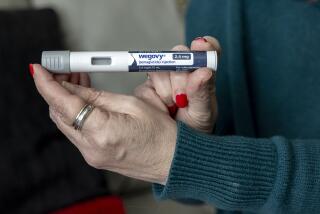Weight-loss surgery aids transplant candidates
Martha Magdaleno suffered from an enlarged heart that left her perennially breathless.
“I couldn’t do anything, like shower,” the 55-year-old mother of four in Inglewood said through an interpreter. “Even when I brushed my teeth, I would be out of breath.”
Her condition grew so severe that, in 2006, cardiologists implanted an artificial heart to assist her failing organ and put her on the waiting list for a transplant. That pump died after eight months, and doctors had to replace it.
Magdaleno was overweight, and doctors placed her on a strict diet. But with her limited physical activity and her poor health, her weight began creeping up. Ultimately, she ballooned to 210 pounds — a massive amount on her 5-foot-3 frame — and doctors removed her from the waiting list. It was simply too risky to perform a heart transplant on someone so obese, they said.
But Dr. Jon Kobashigawa, director of the heart transplant program at the Cedars-Sinai Heart Institute in Los Angeles and Magdaleno’s cardiologist, was determined to get his patient back in shape for a transplant. He sent her to the Khalili Center for Bariatric Care in Beverly Hills, where Dr. Theodore Khalili performed a gastric bypass operation on her in early 2010. As far as anyone knows, it is the only time such weight-loss surgery has been performed on a patient with an artificial heart.
The risky procedure paid off. Magdaleno began losing weight, “about a pound or 2 a week,” she said. By February, her weight had dropped to 165 pounds, and Kobashigawa placed her back on the waiting list. On a Sunday afternoon in June, she had a successful heart transplant, receiving a new organ from a 27-year-old man who died in an accident.
“I feel really good with this heart,” she said with a chuckle. “I have such an urge to live my life to the fullest.”
Bariatric surgery — including adjustable bands, gastric bypass and the stomach-reducing gastric sleeve procedure — is widely acknowledged as an effective way to lose excess weight. A growing body of evidence also demonstrates its potential for combating Type 2 diabetes, reducing or eliminating the need for drugs in as many as 90% of patients, studies show.
Now surgeons are finding another use for it: preparing patients for transplant surgery.
Obesity places patients at high risk for complications during transplant surgery. “The data are very clear,” said Dr. John G. Kral, a professor of medicine and surgery at the State University of New York Downstate Medical Center in Brooklyn. “Obesity very severely affects transplant outcomes.”
In fact, it is a problem for all types of surgery. Dr. Marty Makary of the Johns Hopkins School of Medicine in Baltimore and his colleagues reported in June that obese patients who underwent plastic surgery on the breasts, for example, were 12 times as likely to suffer complications as those of normal weight. Such complications include a higher risk of infections, problems related to anesthesia, increased inflammation, longer operative time and impaired healing.
The bottom line is that patients with a body mass index of more than 33 are not candidates for transplants at most medical centers, Khalili said. (A person with a BMI of 18.5 to 24.9 is considered to have a healthy weight, while a BMI of 25 to 29.9 is considered overweight and anything above 30 is categorized as obese.)
“There is a scarcity of organs, so they want to put them in the patient with the most chances of success,” Khalili said. “Given a choice between a patient with a BMI of 27 and one with a BMI of 35, they’ll put it in the patient where it is most likely to be successful.”
Gastric bypass surgery for overweight and obese transplant candidates “is clearly indicated,” said Kral, who has advocated for its wider use. “It’s a legitimate use of weight-loss surgery.”
So far, the Khalili team has performed bypass surgery on two heart transplant candidates, including Magdaleno, and about 20 patients needing liver transplants; three more heart transplant candidates are lined up. A small number of other surgical groups are also performing the surgery on liver transplant candidates.
“We decided as a team that, even though they are at high risk, the alternative is to do nothing and watch them die,” Khalili said. “It’s a risk worth taking.”
The surgery required a larger-than-usual team in the operating room, including a cardiac anesthesiologist, and critical care specialists in the intensive care unit. Nonetheless, Magdaleno was able to go home three days after her gastric bypass surgery, only a day or two longer than normal, Khalili said.
Sometimes the weight-loss surgery can even avert the need for a transplant.
An accumulation of fat in the liver is the primary causative factor for cirrhosis in about 20% of patients needing a liver transplant, noted Dr. Fred Poordad, a transplant surgeon at Cedars who has referred several candidates to the Khalili Center. In some cases, the weight loss that follows gastric bypass removes enough fat from the liver that the organ can regenerate, alleviating the need for a transplant.
There is not yet enough data to estimate what percentage of such patients ultimately avoid transplants, Kral said, but he guesses that it is on the order of 20%.
Gary Soto hopes he will be one of them. The 55-year-old educational consultant in Corona has diabetes that is complicated by a cirrhotic liver. An older brother and sister both died of these conditions, and Soto said he “panicked” when he developed them as well.
Soto had gastric bypass surgery at the Khalili Center in January 2010 and soon began visiting a dietitian and a physical trainer regularly. He has since lost 104 of his original 309 pounds and no longer has diabetes or high blood pressure.
“I’m very blessed that I am no longer diabetic,” he said. “I am hoping that the fatty liver will also reverse so I don’t have to get a transplant.”
A recent MRI and ultrasound exam show that his liver is indeed less fatty than it was before his surgery. He is not out of the woods yet, but he is well on the way.
Times staff writer Ruben Vives contributed to this report.






